To reduce risk of injury, everyone using, installing,
repairing, maintaining, changing accessories on, or
working near this tool must read and understand
these instructions before performing any such task.
The goal of Chicago Pneumatic is to produce tools that help you work safely and
efficiently. The most important safety device for this or any tool is YOU. Your
care and good judgment are the best protection against injury. All possible
hazards cannot be covered here, but we have tried to highlight some of the
important ones.
3/8" & 1/2" Sq. Dr. Model "A"
CP886/886H
Air Ratchet
Air Supply Requirements
Lubrication
Sound pressure level 98.2 dB(A) in accordance with Pneurop 8N-1. For sound
power, add 10 dB(A).
Maintenance
1. Supply tool with 90 psig (6.2 bar) of clean, dry air. Higher pressure drastically
reduces tool life.
2. Connect tool to air line using pipe, hose, and fitting sizes shown in the diagram on
page 12.
1. Use an air line lubricator with SAE #10 oil, adjusted to two (2) drops per minute. If
an air line lubricator cannot be used, add air motor oil to the inlet once a day.
2. Monthly, lubricate the drive bushing and ratchet yoke with a good grade bearing
grease. Periodically, depending upon use, the ratchet head assembly should be
removed, cleaned and re-greased.
Noise & Vibration Declaration*
2
Vibration value 7.2 m/s , re. ISO 8662-1.
1. Disassemble and inspect air motor every three (3) months if the tool is used
every day. Replace damaged or worn parts.
2. High wear parts are underlined in the parts list.
3. To keep downtime to a minimum, the following service kits, detailed on page
12, are recommended: CA146437 Tune-Up Kit, CA146436 Ratchet Head
Replacement Kit (CP886), CA147668 Ratchet Head Replacement Kit (CP886H)
We, Chicago Pneumatic Tool Company, 1800 Overview Drive, Rock Hill, SC 29730 USA, declare
under our sole responsibility that the product to which this declaration relates, is in conformity with
the requirements of the Council Directive of June 1989 on the approximation of the laws of the
Member States relating to machinery (89/392/EEC).
Machine Name CP886/886H Air Ratchet
Machine Type Assembly Power Tool for Threaded Fasteners - No other use is
permitted.
Serial No. Tools with No. 94300A or higher
Technical Data
3/8" (10 mm) Sq. Dr. Std. (CP886),
1/2" (13 mm) Sq. Dr. Std. (CP886H)
Air pressure 90 psi (6.2 bar)
Torque range 10-50 ft.-lb. (13-70 Nm)
Ult. torque @ 90 psi (6.2 bar) 125 ft.-lb. (170 Nm)
Harmonized Standards Applied EN292
National Standards Applied ISO 8662-1, Pneurop 8N-1
Name And Position Of Issuer W.A. LeNeveu, President, Chicago Pneumatic Tool
Company
* These declared values were obtained by laboratory type testing in compliance with the stated standards and are not
adequate for use in risk assessments. Values measured in individual work places may be higher than the declared
values. The actual exposure values and risk of harm experienced by an individual user are unique and depend upon the
way the user works, the workpiece and the workstation design, as well as upon the exposure time and the physical
condition of the user. We, Chicago Pneumatic, cannot be held liable for the consequences of using the declared values,
instead of values reflecting the actual exposure, in an individual risk assessment in a work place situation over which we
have no control.
Signature Of Issuer
Place And Date Of Issue Utica, NY 13501 USA, November 1, 1994
adapters absorb power and could break. Use deep sockets where possible.
! Never operate the tool off of the work. It may run too fast and cause the
accessory to be thrown off the tool.
! Serious injury can result from over-torqued or under-torqued fasteners,
which can break, or loosen and separate. Released assemblies can become
projectiles. Assemblies requiring a specific torque must be checked using a
torque meter.
Note: So-called "click" torque wrenches do not check for potentially
dangerous over-torque conditions.
Workplace Hazards
! Slip/Trip/Fall is a major cause of serious injury or death. Be aware of excess
hose left on the walking or work surface.
! Maintain a balanced body position and secure footing.
! High sound levels can cause permanent hearing loss. Use hearing protection
as recommended by your employer or OSHA regulation (see 29 CFR part
1910).
! Repetitive work motions, awkward positions and exposure to vibration can
be harmful to hands and arms. If numbness, tingling, pain or whitening of the
skin occurs, stop using tool and consult a physician.
! Always support the tool’s handle securely, in the direction opposite of the
spindle rotation, to reduce the effect of sudden torque reaction during final
tightening and initial loosening.
! An additional support handle or absorption bar may be needed to resist
torque reaction. Absorption bars must be positioned correctly to avoid injury.
! Proceed with care in unfamiliar surroundings. Be aware of potential hazards
created by your work activity.
! Some dust created by power sanding, sawing, grinding, drilling and other
construction activities contains chemicals known to the State of California to
cause cancer and birth defects or other reproductive harm. Some examples
of these chemicals are:
- Lead from lead based paints
- Crystalline silica bricks and cement and other masonry products
- And Arsenic and chromium from chemically-treated rubber
Your risk from these exposures varies, depending on how often you do this
type of work. To reduce your exposure to these chemicals: work in a well
ventilated area, and work with approved safety equipment, such as dust
masks that are specially designed to filter out microscopic particles.
Additional Safety Topics
! The workpiece must be held securely.
! This tool and its accessories must not be modified.
! This tool is not insulated for coming into contact with electric power sources
and is not recommended for use in explosive atmospheres.
! Operators and maintenance personnel must be physically able to handle the
bulk, weight and power of the tool and be capable of performing the job task.
For additional safety information consult:
! Your employer, union and/or trade association.
! US Department of Labor (OSHA); www.osha.gov; Council of the European
Communitieseurope.osha.eu.int
! Safety Code for Portable Air Tools (B186.1) available from: www.ansi.com
! Safety Requirement for Hand-Held Non-Electric Power Tools available from:
European Committee for Standardization, www.cenorm.be
Air Supply and Connection Hazards
! Air under pressure can cause severe injury.
! Always shut off air supply, drain hose of air pressure and disconnect tool
from air supply when not in use, before changing accessories or when
making repairs.
! Never direct air at yourself or anyone else.
! Whipping hoses can cause serious injury. Always check for damaged or
loose hoses and fittings.
! Do not use quick disconnect couplings at tool. See instructions for
correct set-up.
! Whenever universal twist couplings are used, lock pins must be installed.
! Do not exceed maximum air pressure of 90 psi/6.2 bar or as stated on
tool nameplate.
Entanglement Hazards
! Keep away from rotating drive.
! Do not wear jewelry or loose clothing.
! Choking can occur if neckwear is not kept away from the tool
and accessories.
! Scalping can occur if hair is not kept away from the tool and accessories.
! Avoid direct contact with accessories during use.
! Use only proper accessories designed for use with pneumatic screwdrivers,
nutrunners, ratchets and pulse tools.
Projectile Hazards
! Always wear impact-resistant eye protection when involved with or near the
operation, repair or maintenance of the tool or changing accessories on
the tool.
! Be sure all others in the area are wearing impact-resistant eye protection.
! Even small projectiles can injure eyes and cause blindness.
! Do not use hand sockets as they can shatter. Use only power or impact
sockets in good condition.
! Always use the simplest hook-up possible. Long, springy extension bars and
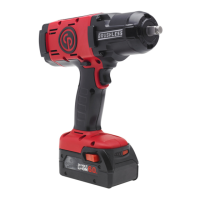
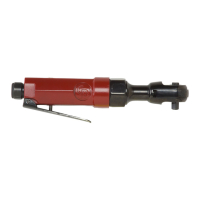
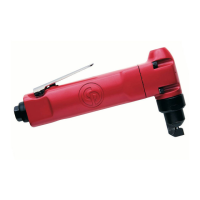

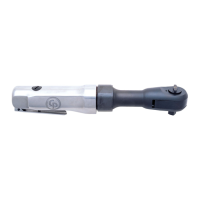

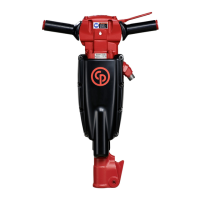

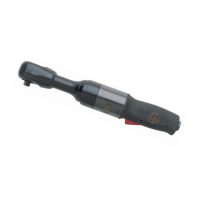
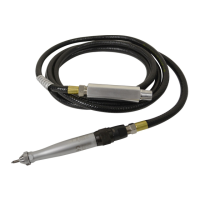
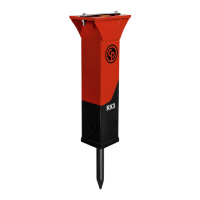
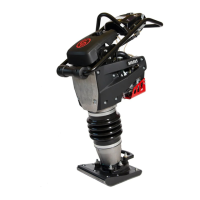
